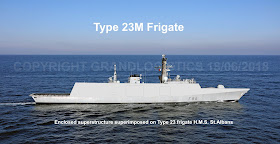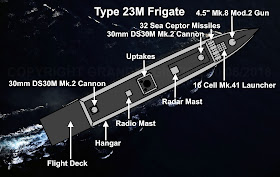This post should not be regarded as an endorsement of the Royal Navy's plan to purchase the Type 31 frigates.
It is the position of this blog that the Royal Navy should have replaced it's Type 22 frigates,Type 23 Frigates and Type 42 destroyers with a single class of multirole surface combatants instead of the Type 45 anti-aircraft destroyer,Type 26 anti-submarine frigate and Type 31 "general purpose" frigates.
Had it done so,it would not be in the mess it is in today.
There would have been no need to develop,manufacture and maintain three different surface combatant hulls and three different propulsion,steering and power generation systems.
There would have been no need to develop,manufacture and maintain two different medium range radars and two different anti-aircraft missile systems.
There would have been neither the need for expensive design,manufacture and support of very low production volume warships,weapons and equipment,nor the need to spend hundreds of millions of pounds on River class patrol vessels to keep ship yards open.
Picture: P.O.A. (Phot.) Ian Arthur,Crown Copyright
The savings from reduced development spending and,more efficient,higher volume manufacturing would have paid for a larger fleet of more capable surface combatants.
This is the Type 23 frigate,which the Royal Navy plans to replace with a combination of eight Type 26 Frigates and five Type 31 frigates.
The Type 23,or Duke Class,is the most successful class of warships designed for the Royal Navy since the Second World War.
Though they are far from perfect,the Type 23s have proven to be perfectly adequate in most respects,unlike their predecessors,the more expensive and less flexible Type 22 frigates.
The £1250 million allocated for the procurement of five Type 31e frigates is similar to the original procurement cost of five Type 23 frigates,after allowing for inflation.
The Type 23 frigates have had long service lives,their longevity is a result of their flexibility,sound design (unlike the preceding Types 21,22 and 42 they have not suffered from structural problems and unlike the succeeding Type 45 they have not suffered from engine problems) and moderate operating costs.
Their moderate operating and procurement costs spread thinly over long service lives have resulted in excellent value for money.
A stark contrast to the shorter lived Type 22 class which,despite costing more to build,was less useful,more expensive to operate and,in the longer,multirole batch three,suffered from hull cracks.
As is the case with military aircraft,multirole ships stay in service for longer,providing better value for money,because they are more useful more often.
The Type 23's most significant weakness,the short range and limited utility of it's Sea Wolf air defence missile system,has been mitigated by it's replacement with the longer ranged and multipurpose Sea Ceptor missile system.
The 4.5" Mark 8 gun has been out ranged by land based artillery guns for over forty years,a significant problem for ships which engage in Naval Gunfire Support (N.G.S.) which cannot be solved by spending forty five million pounds per ship on the 5" Mark 45 gun,which also suffers from the same problem,but which may be solved with our proposed Five and a Half Inch Naval Gun or mitigated at more moderate cost by means of a slower burning propellant and a longer barrel for the 4.5" Mark 8 gun,to increase it's range and reduce time of flight at all ranges.
Picture: Katie Chan
The Type 23 frigate's two DS30M Mark 2 30mm Automated Small Calibre Guns are unable to fire dead ahead and astern and,as they do not cover overlapping sectors,only one gun may be brought to bear on any target with no redundancy in the event that a gun is unavailable due to technical failure,battle damage or a lack of ammunition (this very poor design is common to many British warships).
In emergencies and when performing special tasks a single helicopter hangar is a significant inconvenience,even for a ship which routinely carries only one helicopter.
The Type 23's boats' lack of horse power,fire power and protection may be a cause of embarrassment to naval boarding parties.
The Royal Navy is often unable to participate in cruise missile bombardments,one of the most common naval engagements,due to a total absence of long range land attack missiles on it's surface warships.
When the ship's helicopter is unavailable (due to maintenance,technical failure,battle damage,crew fatigue,weather,refuelling,rearming or accident),the Type 23's only anti-submarine weapon is the light weight Stingray torpedo which is out ranged by the heavy weight torpedoes used by submarines.
This is the Type 23M frigate,our proposed replacement for five Type 23 frigates,which is intended to satisfy the Type 31 requirement and to provide a basis for an entry to the United States' Navy's F.F.G.(X.) competition.
The superstructure of the Type 23M shall be enclosed to increase structural depth,increase reserve buoyancy,increase internal volume,reduce maintenance and reduce electromagnetic reflections,added top weight being counter ballasted by thicker bottom plates (doors shown concealing the boats and replenishment equipment may be omitted to reduce weight,cost and maintenance).
From the flight deck level upwards,Type 23M frigates shall be parallel sided from the front of the superstructure back to the transom in order to reduce the cost of design and construction,increase righting moment and structural width,widen the flight deck and maximise useable internal volume.
The Type 23M shall be a modernised Type 23 frigate,based on the same hull form,with similar internal arrangements and using much of the same,newly built or refurbished,equipment as the current Type 23 frigates.
New types of equipment shall be specified only where it is operationally or financially beneficial.
For example,to replace obsolescent components,reduce manpower requirements,reduce maintenance or reduce fuel consumption.
The two,venerable,Rolls Royce Spey gas turbines of the original Type 23 frigate shall be replaced with a single,more efficient,Rolls Royce MT30 gas turbine on the Type 23M (these also being used by the Type 26 frigates and Queen Elizabeth class aircraft carriers) to extend the vessel's range and endurance.
The Type 23M shall use the same,recently upgraded,Rolls Royce M.T.U. 12V 4000 M53B diesel generators as the current Type 23 frigates.
The Type 23M shall use newer and more efficient electric propulsion motors than those fitted to the current Type 23 frigates to extend it's range and endurance.
The Type 23M shall use the same propellers,shafts,seals and bearings as the current Type 23 frigates.
The Type 23M shall use the same rudders and steering gear as the current Type 23 frigates.
The Type 23M shall use the same,recently upgraded,towed and hull mounted,sonars and countermeasure systems as the current Type 23 frigates.
The Type 23M shall use the same,recently upgraded,Artisan and SharpEye radars as the current Type 23 frigates.
The Type 23M shall use the same Sea Ceptor missiles which are being fitted to the current Type 23 frigates.
The Type 23M shall use the same DS30M 30mm cannon as the current Type 23 frigates but shall carry them atop the bridge and hangar where they shall cover wider,overlapping,sectors and be able to fire ahead and astern.
The Type 23M shall use the same Merlin and Wildcat helicopters,with the same support equipment,as the current Type 23 frigates but shall have a wider hangar,able to accommodate two Merlins when needed,and a wider flight deck.
The Type 23M shall use two Pacific 950 boats,with more power,payload,protection and firepower than the two Pacific 24 boats carried by the current Type 23 frigates.
Picture: Intelligence Specialist 1st Class Kenneth Moll,United States Navy photograph
The Type 23M shall use two,eight cell,strike length Mark 41 Vertical Launch System modules,in a narrow vee configuration,in lieu of the eight Harpoon Mark 141 Guided Missile Launch System on the current Type 23 frigates,enabling the use of vertically launched anti-ship,anti-submarine and land attack missiles,a typical payload being eight vertically launched Anti Submarine Rockets (V.L-A.S.ROC.) or Spearfish Torpedoes and eight dual purpose Tomahawk or Perseus missiles.
The Type 23M shall use two,eight cell,strike length Mark 41 Vertical Launch System modules,in a narrow vee configuration,in lieu of the eight Harpoon Mark 141 Guided Missile Launch System on the current Type 23 frigates,enabling the use of vertically launched anti-ship,anti-submarine and land attack missiles,a typical payload being eight vertically launched Anti Submarine Rockets (V.L-A.S.ROC.) or Spearfish Torpedoes and eight dual purpose Tomahawk or Perseus missiles.
A lighter,cheaper,more flexible and less intrusive alternative to the strike length Mark 41 launcher which may be fitted to the Type 23M,Type 23,Type 26 frigates and Type 45 destroyers,is to have Spearfish torpedoes and Perseus,Tomahawk,Harpoon or Naval Strike Missiles launched from canisters on the fore deck (along with a single eight cell tactical length Mark 41 launcher for thirty two quad packed Sea Ceptor missiles on the Type 23M).
The Type 23M shall use either the same Magazine Torpedo Launch System and Stingray lightweight torpedoes as the current Type 23 frigates,supplemented by a handful of vertically launched anti-submarine missiles for use when the helicopter is not available or,preferably,canister,tube or vertically launched Spearfish heavyweight torpedoes which shall be useful against both submarines and surface ships.
The Type 23M,or Type 23 Batch 2,frigates shall be known as the Duke of Cambridge or Royal Duke class after the lead ship H.M.S. Cambridge,her sister ships being Cornwall,Edinburgh,Gloucester,Normandy and,should further funding become available,Rothesay,Sussex and York.




































